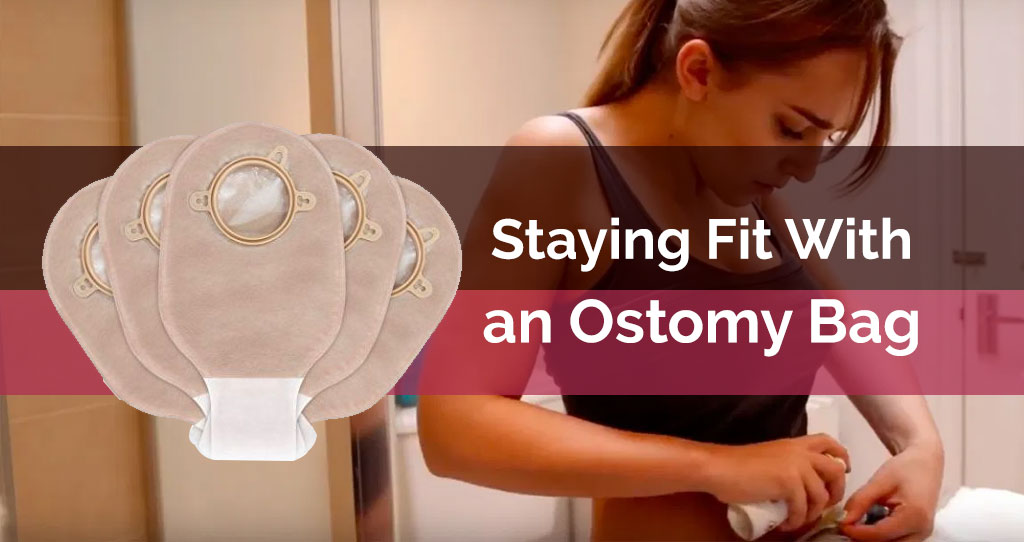Life after stoma surgery can be challenging at first, but with proper medical advice and a firm resolve, you can get back to your exercise routine in no time. There are plenty of ways to stay healthy and keep in shape; you just need to find what suits you best.
In this guide, we'll provide an introduction to stoma-safe exercises, including advice and tips on what to do after your surgery.
Before We Start
Every case and patient is different.
Some people might have a faster recovery, while others require extended post-op care. For this reason, you need a medical professional to guide you every step of the way.
Whether you're interested in trying out a new exercise or meal plan, always consult with your doctor first.
Strengthening Techniques

Ostomy Bag
After surgery, your GP or stoma nurse will advise you on how to recover faster. They will teach you how to cough correctly to prevent agitating your wound and even show you some regular exercises to strengthen your abdominal muscles.
With your doctor's approval, here are some simple techniques you can include in your post-op routine:
- Lie on your back on a floor or bed with knees above your chest and feet off the floor. Roll your knees slowly from side to side and reach as far as you comfortably can.
- Sit on a chair and place your feet firmly on the ground. Try to pull in your abdominal muscles if you can and breathe slowly. While breathing, slowly stand while keeping your abdomen tight if possible. You can do this routine twice a day with ten repetitions.
- Sit on a chair with your upper body slightly forward and your feet firmly on the ground. Pull in your abdominal muscles and slowly raise one foot about four inches from the floor while breathing out. Lower your foot and do the same with the other.
Lie on your back, carefully tilt your pelvis upward, then go back to the resting position multiple times, as long as you feel comfortable doing so.
Colostomy Bag Exercises
Once you've fully healed, you can now resume your everyday life and focus on staying fit.
Many believe that living with an ostomy leaves you with few options for physical activities. However, this is a complete myth!
Below are just some of the colostomy bag exercises you can try out.
General Tips
- Always consult a fully trained professional before trying out a new routine
- Consider wearing an Ostomy Support Belt for extra security
- Follow a healthy diet recommended by your doctor
- Avoid physical contact sports like rugby or boxing
- Wear comfortable clothing and shoes
- Learn to pace yourself
Drink water regularly
Walking
One of the best exercises you can try even right after surgery is walking.
Remember to start slowly and set manageable goals for yourself.
Once your body is acclimated, you can begin increasing the distance.
Don't push yourself too hard! If you're starting to feel pain, it's your body telling you to take a break.

Ostomy Bag
Running

Ostomy Bag
Once you've healed enough and consulted with your doctor, you can slowly incorporate running into your routine.
If you're already a regular walker, you can switch between running and walking every couple of minutes to build up your stamina.
Like any other physical activity, always ease into it until your body adjusts.
Many ostomates are afraid of their pouch leaking or loosening when doing rigorous movements, but you can feel more comfortable with the proper support. As we mentioned above, the design of many products like the ostomy support belt supports the core and keeps your implements in place.
Swimming
Some ostomates steer clear from swimming and other water-related activities because of their stoma bag, but this is far from necessary. Almost all stoma bags used nowadays are discrete, water-resistant, and leakproof when fitted correctly.
Other available options include urostomy, colostomy, or ileostomy bags with stoma caps if you want something less noticeable.

Ostomy Bag
Consult with your stoma nurse for advice on these products. You can also find many high-quality support belts made from lightweight materials that dry quickly as soon as you're out of the water.
Yoga

Ostomy Bag
If you want to try out yoga, ask your doctor if your body can handle prolonged physical activity.
Most yoga poses rely on your core strength, so it's a good practice to make sure that your abdominal muscles are strong enough and your wound has fully healed.
Once you're ready, you can begin with yoga styles that are less taxing for the body.
Hatha and Restorative yoga are great examples because they focus on slower movements and deep relaxation. Don't start right off the bat with intense styles like Ashtanga or Bikram yoga.
Pilates
Pilates has many gentle routines that you can try with a few repetitions.
This activity is excellent for ostomates because it focuses on strengthening your core muscles to help support your spine and balance your body.
With a healthier back and stomach, you have fewer chances of getting an abdominal hernia.

Ostomy Bag
Weightlifting

Ostomy Bag
As a general rule, you shouldn't start lifting weights until at least three months after your surgery.
Otherwise, you have a high risk of agitating your wound or getting a hernia.
Always consult with your doctor beforehand and use the lightest weights possible to start.
Sit in an upright position, pull in your abdominal muscles, and slowly raise your arms while holding weights. Take slow, deep breaths during your routine. Don't hold your breath because this exerts pressure on your stomach.
Sticking to Your Routine
Always give your body the time it needs to adjust and heal because everyone recovers at different rates. Becoming an ostomate can be the catalyst for a better lifestyle. Over time, making health-conscious decisions can become second nature to you.
Having a stoma won't prevent you from doing what you love and staying fit, be it with gardening, swimming, or even weightlifting!










